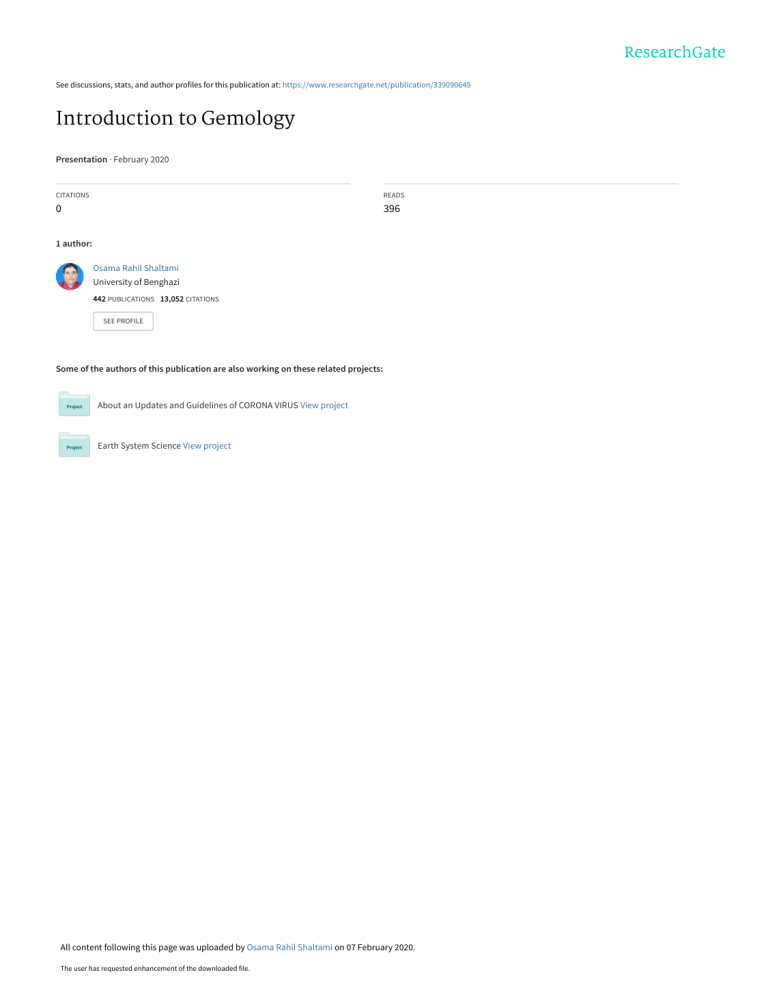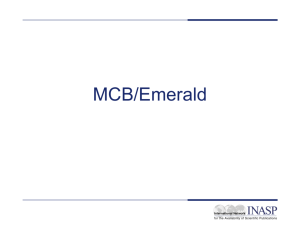
See discussions, stats, and author profiles for this publication at: https://www.researchgate.net/publication/339090649 Introduction to Gemology Presentation · February 2020 CITATIONS READS 0 396 1 author: Osama Rahil Shaltami University of Benghazi 442 PUBLICATIONS 13,052 CITATIONS SEE PROFILE Some of the authors of this publication are also working on these related projects: About an Updates and Guidelines of CORONA VIRUS View project Earth System Science View project All content following this page was uploaded by Osama Rahil Shaltami on 07 February 2020. The user has requested enhancement of the downloaded file. LECTURE FOR UNDERGRADUATE STUDENTS INTRODUCTION TO GEMOLOGY Dr. Osama Shaltami Department of Earth Sciences Faculty of Science, Benghazi University, Libya Introduction Nearly 4000+ varieties of minerals are identified in nature; only a few are referred as gem minerals due to their exceptional qualities and properties. Gems have been a part of human history for more than 5000 years. Throughout the ages gemstones have been seen as representations of wealth, power and symbols of supremacy. Gem minerals are usually hard and relatively free from cleavage and occur as transparent crystals, with few exception such as opal, fluorite etc., Thus gemstones are artificially polished fragments (faceted or with smooth curved finish). The study of gemstones is an accepted part of Mineralogy . A gem is a naturally occurring material desirable for its beauty, valuable in its rarity, and sufficiently durable to give lasting pleasure. Gemology- is the subject matter the scientific study of gemstones (from its genesis to valuation). Lapidary – is the science of cutting and polishing a gem mineral. Over the centuries numerous magical and medicinal properties were attributed to precious stones. In Ayurveda (Indian System of Medicine) Audbhida-Extract form Plants, Jangama-Extract from Animals Parthiva-Extract from Metals and Minerals Different types of BHASMA such as Hirka Bhasma (Diamond), Manikya Bhasma (Ruby), Swarna Bhasma (Gold), Abhraka Bhasma (Mica) etc. were prepared from metals and minerals to cure variety of diseases. CLASSIFICATION OF GEMSTONES • Gemstones are classified based on certain assertive aspects /parameters. viz., 1. TYPES Organic Imitation Inorganic Synthetic 2. Based on Availability Availability Precious Semi-Precious The precious and semi precious classification of gemstones is largely based on the Market (Demand and Supply); it is an arbitrary classification based on local availability. 3. OTHER TYPE CLASSIFICATIONS Chemical Composition Optical Characters Durability Crystal Structure Physical and Optical properties are the Key elements to distinguish various types of gemstones Physical Properties • • • • • • • • • • • Color * Streak Habit Cleavage, Parting Plane, Fractures. Lustre (Reflectivity) Diaphaneity (Transmisivity) Hardness* Specific Gravity Tenacity & Toughness Chatoyancy Asterism Optical Properties • • • • • • Refractive Index Dispersion Pleochroism Interference Figures Optic Axis Optic Sign COLOUR CAUSING TRANSITION METAL ELEMENTS IN IDOCHROMATIC GEMS Chromium Iron Manganese Copper Green Green Red blue Pink orange Blue Green Red Uvarovite Peridot Almandine lazurite Rhodocrosite, Rodonite Spessartite Azurite, Turquoise, Chrysocolk Malachite, Dioptase Cuprite COLOUR CAUSING TRANSITION METAL ELEMENTS IN ALLOCHROMATIC GEMS Chromium Green Red Emerald, Gromularite, Cr-tourmaline, Cr-Chalcedony, Alexandrite Ruby, Spinal, Topaz, Alexandrite Chromium + Iron Red Green Pyrope Jadeite, Diopside, Synthetic OPX Cobalt Blue Syn. Spinel, Syn. Quartz & Glass. Iron Green Yellow Blue Violet – blue Red Aquamarine, Tourmaline, Green Sapphire, Chrysoberyl, Epidote. Yellow sapphire, Citrine, Chrysoberyl, Orthoclase, Soundmen. Aquamarine, Spinal. Tanzanite, Iolite. Eudialyte Iron + Titanium Manganese Blue Pink Yellow Green Violet Nickel Green Vanadium Green Blue – Green to Purple – red Blue Sapphire Rhodonite, Rhodocrosite, Piedmmtite, Syn. OPX. Andalusite Tremolite Syn. Olivine. V- Emerald V- Grossularite V- Sapphire Syn. CPX The main parameters of GEMSTONE • BEAUTY • RARITY • DURABILITY Gemstones are measured in terms metric carat, which is equivalent to 200mg (1 carat is equivalent to 0.2 grams). A CARAT is again sub divided into hundred POINTS (2mg). Gem Testing & Gemologist Certificate: Gemstones are identified based on their properties (P & O) along with few instruments (Chelsea filter, Refractrometer, Gemological Microscopes, Hardness Pencils etc.). The efficiency of a gemologist lies in identifying a stone without subjecting it to any kind of destructive tests. A certificate from a certified GEMOLOGIST would certainly yield to its market, through proper identification and valuation. Valuation of Gemstones valuation of gemstones is done through the 4 C’s precept. Color Clarity Cut & Carat Weight EXPLORATION Exploration: Refers to geological, geochemical and geo-physical field work and complimentary laboratory studies directed to the discovery of workable mineral concentration. Gemstone occurrence is a very rare and a transient geologic feature; once exhausted replenished with in a short time. cannot be Diverse minerals are formed at different geological environments in different rock types, viz Igneous, Sedimentary and Metamorphic rocks, also few organically. For Example: Diamonds in Kimberlites (Ultra-mafic HTHP) Beryl in Pegmatites Quartz in Felsic rocks Peridot in Ultra mafic rocks Garnets in Metamorphic Rocks T h e p rin c ip le r o le o f a n E x p lo r a t io n G e o lo g is t G e m Q u a l it y E m e r a ld C r y s t a l in Q u a r t s a nd H o st Roc k E s s e n t ia l M in e r a l A lm a n d in e G a r n e t e m b e d d e d in BERYL By the name Beryl is a Silicate of Beryllium and Aluminum; is the principle store of beryllium in the earth's crust. In its rare gem form it is notable for a variety of vivid allochromatic color with vivid names. Chemical Composition: Be3Al2Si6O18 • Crystal System: Hexagonal • Habit: Usually well formed hexagonal prisms, either flattened or elongate, with pinacoidal terminations. • Hardness: 7.5-8 • Specific Gravity: 2.67-2.78 • Refractive Index: 1.57-1.59 Distinguishing Properties • Low R.I • Low S.G* • Dichroism • Low Birefringence Distribution: Common rocks that hosts Beryl are Granites and Pegmatites. Vugs in these rocks may consists of fine crystals of Beryl, Tourmaline, Topaz, Spodumene etc. Mineralization occurs, where the Pegmatites intruding the basis and ultra-basic rocks yield important gem deposits*. Varieties of Beryl Sl No. Variety Color Cause 1 Goshenite Uncolored No Specific Cause 2 Heliodor Yellow UVCT (O2-- Fe3+) 3 4 Aquamarine Green Beryl Blue Green 5 6 Morganite Bixbite Pink Red IVCT (Fe2+ Fe3+) UVCT+IVCT Mn2+ Mn2+ 7 Maxixe Blue Color Centre (No3) 8 Maxixe -typed Blue 9 Emerald Color Centre (Co3) Cr3+/ V3+ Green (Velvety) Emerald Velvety green variety of Beryl if known as Emerald. CC: Be3(Al,Cr)2 Si6O18 The typical velvety green hue of emerald is distinctive. The green shade of emerald caused on the account of chromium/vanadium impurity. RI- 1.578-1.584; SG- 2.72 Aquamarine • Palish blue, light blue green variety of beryl is known as aquamarine. • Sky blue color stone is the most valuable aquamarine. • They exhibits a greenish blue tinge due the phenomenon of pleochroism. • Golden colored variety of beryl is known as Golden beryl. • The yellow color is due to the presence of Fe3+ in concentration of over 1%. a • Yellow green variety of beryl is known as Heliodor. • Yellow green olive color is the typical character of Heliodor. • Bixbite is an extremely rare variety of beryl. • Bixbite is strong ruby red or violet red in color. • Very rarely found, have an different genesis to that of In found in pegmatite. extrusive magmatic rocks. • The red color is due to the presence of Mn2+ is as an their crystal impurity in structure. Case Study: Ndola Rural Emerald Fields, Zambia • Nolda –Rural Emerald field of the Zambian Republic represents a good source of easily mined emeralds. • To this day, many areas are a preserve of artisinal miners. Lack of capital has lead to inefficient exploration and exploitation. GEOLOGICAL SETUP: • Zambia lies in between Zaire and the Zambian cratons characterized geologically as being ancient mobile belt; comprising of Igneous, Sedimentary and metamorphic formations of the Precambrian age. • Mineralization in the Ndola Rural Emerald Fields occurs where the quartz-tourmaline-pegmatite veins intrude the talc-chlorite-tremolite-magnetite schist and alter the contact zone as biotite-phaloghite rock, this alteration zone forms the chief ore body. Three distinct varieties of pegmatite are known in the study area: 1st Generation: initial feeder phase rich in quartz and feldspar and contain minor fine grained tourmaline and not related to mineralization. 2nd Generation: veins composed largely of tourmaline commonly associated with emerald mineralization. • • •3 rd Generation: composed of coarse quartz tourmaline (5-10 mm) always found in association with mineralization of emerald. • The distribution of emerald is very erratic; major emerald mineralization, rich in volume & grade are associated with flat lying undulating veins and number of vein intersects. • Granitic emplacement characterized by intensive pulses of pegmatite activity rich in minerals B, Be, F etc intruding through the well developed shear system appears to be the cause. • Crystallization of beryl appears to have taken place during metasomatic reaction between the slow cooling pegmatite (3rd Generation) and the surrounding schist. The role of a GEOLOGIST in the field of • • • • • Gemological Science: Prospecting of a gem deposit. Establishing the properties of gem minerals. Identification of stone in cut and rough form. Enhancement of stone (synthesis). Minerals grow in a definite physico-chemical environment, thus a geologist is better able to understand and reason out the paragenesis of a mineral or gemstone. It is easy to distinguish a natural stone from its synthetic counterpart. Thanks View publication stats



